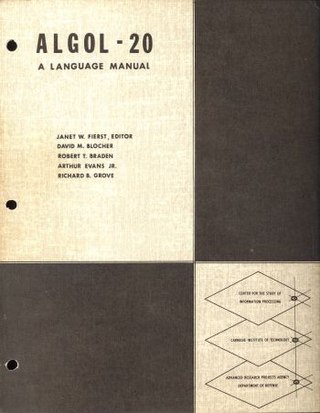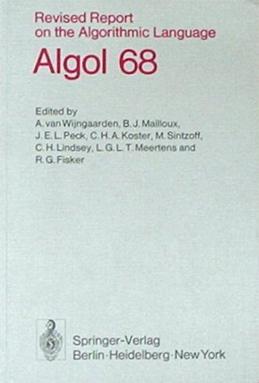Related Research Articles

ALGOL is a family of imperative computer programming languages originally developed in 1958. ALGOL heavily influenced many other languages and was the standard method for algorithm description used by the Association for Computing Machinery (ACM) in textbooks and academic sources for more than thirty years.
C is a general-purpose computer programming language. It was created in the 1970s by Dennis Ritchie, and remains very widely used and influential. By design, C's features cleanly reflect the capabilities of the targeted CPUs. It has found lasting use in operating systems, device drivers, and protocol stacks, but its use in application software has been decreasing. C is commonly used on computer architectures that range from the largest supercomputers to the smallest microcontrollers and embedded systems.
Icon is a very high-level programming language based on the concept of "goal-directed execution" in which code returns a "success" along with valid values, or a "failure", indicating that there is no valid data to return. The success and failure of a given block of code is used to direct further processing, whereas conventional languages would typically use boolean logic written by the programmer to achieve the same ends. Because the logic for basic control structures is often implicit in Icon, common tasks can be completed with less explicit code.
Pascal is an imperative and procedural programming language, designed by Niklaus Wirth as a small, efficient language intended to encourage good programming practices using structured programming and data structuring. It is named after French mathematician, philosopher and physicist Blaise Pascal.
BASIC09 is a structured BASIC programming language dialect developed by Microware on behalf of Motorola for the then-new Motorola 6809 CPU and released in February 1980. It is primarily used with the OS-9 operating system, released in 1979. Microware also released a version for OS-9/68k on the 68000 as Microware BASIC.
Hungarian notation is an identifier naming convention in computer programming in which the name of a variable or function indicates its intention or kind, or in some dialects, its type. The original Hungarian notation uses only intention or kind in its naming convention and is sometimes called Apps Hungarian as it became popular in the Microsoft Apps division in the development of Microsoft Office applications. When the Microsoft Windows division adopted the naming convention, they based it on the actual data type, and this convention became widely spread through the Windows API; this is sometimes called Systems Hungarian notation.

In computer science and computer programming, a data type is a collection or grouping of data values, usually specified by a set of possible values, a set of allowed operations on these values, and/or a representation of these values as machine types. A data type specification in a program constrains the possible values that an expression, such as a variable or a function call, might take. On literal data, it tells the compiler or interpreter how the programmer intends to use the data. Most programming languages support basic data types of integer numbers, floating-point numbers, characters and Booleans.
ALGOL W is a programming language. It is based on a proposal for ALGOL X by Niklaus Wirth and Tony Hoare as a successor to ALGOL 60. ALGOL W is a relatively simple upgrade of the original ALGOL 60, adding string, bitstring, complex number and reference to record data types and call-by-result passing of parameters, introducing the while statement, replacing switch with the case statement, and generally tightening up the language.
In computer science, a union is a value that may have any of several representations or formats within the same position in memory; that consists of a variable that may hold such a data structure. Some programming languages support special data types, called union types, to describe such values and variables. In other words, a union type definition will specify which of a number of permitted primitive types may be stored in its instances, e.g., "float or long integer". In contrast with a record, which could be defined to contain both a float and an integer; in a union, there is only one value at any given time.
In computer science, a record is a basic data structure. Records in a database or spreadsheet are usually called "rows".
Dartmouth BASIC is the original version of the BASIC programming language. It was designed by two professors at Dartmouth College, John G. Kemeny and Thomas E. Kurtz. With the underlying Dartmouth Time Sharing System (DTSS), it offered an interactive programming environment to all undergraduates as well as the larger university community.
In computer science, type conversion, type casting, type coercion, and type juggling are different ways of changing an expression from one data type to another. An example would be the conversion of an integer value into a floating point value or its textual representation as a string, and vice versa. Type conversions can take advantage of certain features of type hierarchies or data representations. Two important aspects of a type conversion are whether it happens implicitly (automatically) or explicitly, and whether the underlying data representation is converted from one representation into another, or a given representation is merely reinterpreted as the representation of another data type. In general, both primitive and compound data types can be converted.

ALGOL 68 is an imperative programming language that was conceived as a successor to the ALGOL 60 programming language, designed with the goal of a much wider scope of application and more rigorously defined syntax and semantics.
The computer programming languages C and Pascal have similar times of origin, influences, and purposes. Both were used to design their own compilers early in their lifetimes. The original Pascal definition appeared in 1969 and a first compiler in 1970. The first version of C appeared in 1972.
S-algol is a computer programming language derivative of ALGOL 60 developed at the University of St Andrews in 1979 by Ron Morrison and Tony Davie. The language is a modification of ALGOL to contain orthogonal data types that Morrison created for his PhD thesis. Morrison would go on to become professor at the university and head of the department of computer science. The S-algol language was used for teaching at the university at an undergraduate level until 1999. It was also the language taught for several years in the 1980s at a local school in St. Andrews, Madras College. The computer science text Recursive Descent Compiling describes a recursive descent compiler for S-algol, implemented in S-algol.
Systems Programming Language, often shortened to SPL but sometimes known as SPL/3000, was a procedurally-oriented programming language written by Hewlett-Packard for the HP 3000 minicomputer line and first introduced in 1972. SPL was used to write the HP 3000's primary operating system, Multi-Programming Executive (MPE). Similar languages on other platforms were generically referred to as system programming languages, confusing matters.
In computer programming, a function or subroutine is a sequence of program instructions that performs a specific task, packaged as a unit. This unit can then be used in programs wherever that particular task should be performed.

A BASIC interpreter is an interpreter that enables users to enter and run programs in the BASIC language and was, for the first part of the microcomputer era, the default application that computers would launch. Users were expected to use the BASIC interpreter to type in programs or to load programs from storage.
Wang BASIC is a series of BASIC programming languages for computers from Wang Laboratories. The term can be used to refer to the BASIC on any Wang machine, but is mostly associated with the versions on the Wang 2200 minicomputer series of the early 1970s. When these machines were updated to the VP series in 1976, BASIC-2 was introduced and remained the pattern for future machines in the 2200 series. A planned BASIC-3 was never released.
Acorn System BASIC and Atom BASIC are two closely related dialects of the BASIC programming language developed by Acorn Computers for their early microcomputers like the Acorn System 3 and Acorn Atom. Developed in-house, they have a number of significant idiosyncrasies compared to most BASIC dialects of the home computer era.
References
- ↑ Slimick 1971, p. 22.
- 1 2 Reiser 1976, p. iii.
- 1 2 3 Smith 1976, p. 13.
- 1 2 Smith 1976, p. 48.
- 1 2 3 Smith 1976, p. 11.
- ↑ Smith 1976, p. 15.
- ↑ Smith 1976, p. 17.
- ↑ Smith 1976, p. 19.
- ↑ Smith 1976, p. 18.
- 1 2 3 Smith 1976, p. 21.
- 1 2 Smith 1976, p. 22.
- ↑ Smith 1976, p. 23.
- ↑ Smith 1976, p. 24.
- ↑ Smith 1976, p. 2.
- ↑ Smith 1976, p. 4.
- ↑ Smith 1976, p. 5.
- ↑ Smith 1976, p. 6.
- 1 2 Smith 1976, p. 12.
- ↑ Smith 1976, p. 40.
- 1 2 Smith 1976, p. 41.
- ↑ Smith 1976, p. 27.
- ↑ Smith 1976, p. 28.
- ↑ "strtok() and strtok_r() functions in C with examples".
- ↑ Smith 1976, p. 32.
- ↑ Smith 1976, p. 33.
- ↑ Smith 1976, p. 30.
- ↑ Smith 1976, pp. 2, 38.
- 1 2 Smith 1976, p. 25.
- ↑ Smith 1976, p. 26.
- ↑ Smith 1976, p. 44.
- ↑ Reiser 1976, p. 83.
- ↑ "PUB Manual". Nomodes.com. Archived from the original on 5 February 2005. Retrieved 30 December 2017.
- ↑ Rodbard, D.; Cole, B. R.; Munson, P. J. (1983). "Development of a Friendly, Self-Teaching, Interactive Statistical Package for Analysis of Clinical Research Data: The BRIGHT STAT-PACK". Proc Annu Symp Comput Appl Med Care. 8 (3): 701–704. doi:10.1007/BF02224505. PMC 2578281 . PMID 6384409.
- ↑ Stetten, DeWitt (10 May 2014). NIH: An Account of Research in Its Laboratories and Clinics. Academic Press. ISBN 9781483277554 – via Google Books.
- ↑ "STANFORD UNIVERSITY MEDICAL EXPERIMENTAL COMPUTER RESOURCE : RR - 00785 : ANNUAL REPORT - YEAR 05". Profiles.nlm.nih.gov. Retrieved 30 December 2017.
- ↑ "Annual report : National Institutes of Health. Division of Computer Research and Technology". Archive.org. Bethesda, Md. Retrieved 30 December 2017.
- ↑ Zhulin, Denis Larionov & Alexander. "Read the eBook Annual report : National Institutes of Health. Division of Computer Research and Technology (Volume 1981-83) by National Institutes of Health (U.S.). Division of online for free (page 4 of 56)". Ebooksread.com. Retrieved 30 December 2017.
- ↑ "PUFF/VM PROJECT : Section 4.1.6". Profiles.nlm.nih.gov. Retrieved 30 December 2017.
- ↑ "Section 9.2.6 : PUFF/WI Project". Profiles.nlm.nih.gov. Retrieved 30 December 2017.
- ↑ "Section 4.1.7 : PUFF/VM Project". Profiles.nlm.nih.gov. Retrieved 30 December 2017.
- ↑ "STANFORD UNIVERSITY MEDICAL EXPERIMENTAL COMPUTER RESOURCE : RR - 00785 : ANNUAL REPORT -YEAR 05" (PDF). Profiles.nlm.nih.gov. Retrieved 30 December 2017.
Bibliography
- Reiser, John (August 1976). SAIL (PDF) (Technical report). Stanford Artificial Intelligence Laboratory.
- Smith, Nancy (October 1976). SAIL Tutorial (PDF) (Technical report). Stanford Artificial Intelligence Laboratory.
- Slimick, John (October 1971). "Current Systems Implementation Languages: One User's View" (PDF). ACM SIGPLAN Notices. 6 (9): 20–28. doi:10.1145/942596.807056.